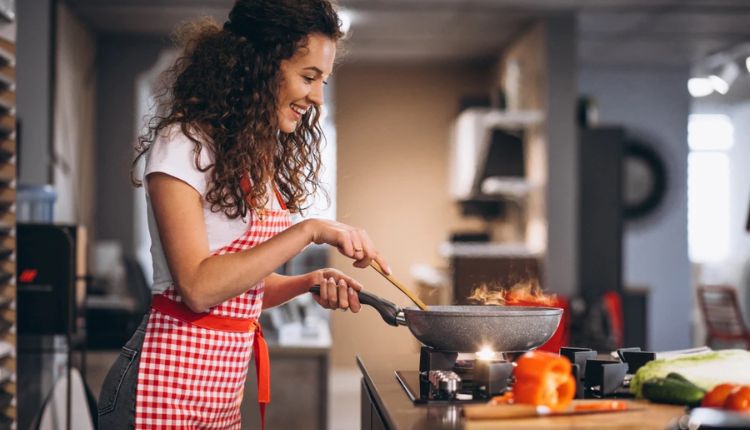Are you looking at your fridge and sighing, once again? Between the ready meals piling up and the guilt growing each evening, you wonder how to rediscover the pleasure of cooking healthily. Don’t worry, you’re not alone in this situation. Adopting a balanced diet doesn’t require hours in the kitchen or a chef’s diploma. With a few simple recipes and basic techniques, you can transform your eating habits while enjoying delicious food.
Why does balanced cooking seem so complicated?
The food industry has managed to make us believe that eating well requires time and special skills. Yet our grandmothers cooked balanced meals daily without asking a thousand questions. They used fresh seasonal products, varied vegetables according to availability, and prepared simple but tasty dishes.
The real secret lies in organization and choosing the right recipes. There’s no need to spend three hours in the kitchen to prepare a nutritious meal. With the right techniques, you can cook a complete and balanced dish in 20-30 minutes maximum. The key is to master a few basic recipes that you can then adapt according to your tastes and available products.
Fear of failure also holds back many people. You imagine that cooking balanced meals means bland or complicated dishes. Think again: well-prepared vegetables are full of flavor, whole grains bring interesting textures, and proteins can be cooked in a thousand delicious ways.
How to compose a balanced meal without stress?
A balanced meal follows a simple formula: one portion of vegetables (half your plate), one portion of whole grains or starches (a quarter), and one portion of protein (the last quarter). Add a little quality fat and you get a complete meal that nourishes your body and satisfies your taste buds.
This distribution ensures a varied intake of essential nutrients. Vegetables provide vitamins, minerals, and fiber. Whole grains provide lasting energy through carbohydrates. Proteins, whether animal or plant-based, including options like amazon organic protein powder, allow for the construction and repair of your tissues.
Vary the colors on your plate to maximize nutritional diversity. A colorful dish generally indicates a good variety of nutrients. Red tomatoes, green spinach, orange carrots, purple eggplants: each color corresponds to specific antioxidants beneficial to your health.
Recipe 1: Quinoa Salad with Crunchy Vegetables
Ingredients for 4 people:
- 200g white quinoa
- 400ml vegetable broth
- 2 medium zucchini
- 200g cherry tomatoes
- 1 red bell pepper
- 150g feta cheese
- 50g sunflower seeds
- 4 tablespoons olive oil
- 2 tablespoons balsamic vinegar
- 1 bunch fresh mint
- 1 bunch flat-leaf parsley
- Salt and pepper
Preparation (total time: 25 minutes)
Step 1: Cook the quinoa (15 minutes) Rinse the quinoa under cold water until the water runs clear. In a saucepan, bring the broth to a boil, add the quinoa and reduce heat. Simmer covered for 15 minutes. The quinoa should absorb all the liquid and the grains should be tender.
Step 2: Prepare the vegetables (10 minutes) While the quinoa cooks, wash and cut the zucchini into small dice. Cut the cherry tomatoes in half, the bell pepper into thin strips. For precise and uniform cutting that enhances the presentation of your vegetables, use a sharp knife that makes work easier and guarantees clean results.
Step 3: Assemble the salad (5 minutes) Fluff the quinoa with a fork and let it cool. Mix it with the cut vegetables, crumbled feta, and sunflower seeds. Prepare the dressing by mixing olive oil, balsamic vinegar, salt, and pepper.
Step 4: Finish (2 minutes) Add the chopped herbs and dressing just before serving. Mix gently to avoid crushing the feta. This salad keeps for 2 days in the refrigerator and can be eaten cold or warm.
Recipe 2: Salmon en Papillote with Seasonal Vegetables
Ingredients for 4 people:
- 4 salmon fillets of 120g each
- 2 zucchini
- 2 carrots
- 200g broccoli
- 4 tablespoons olive oil
- 4 sprigs fresh thyme
- 2 lemons (juice and zest)
- 4 garlic cloves
- Sea salt and black pepper
- 4 sheets of parchment paper
Preparation (total time: 30 minutes)
Step 1: Prepare the vegetables (10 minutes) Preheat your oven to 200°C (400°F). Wash and cut the zucchini into rounds, carrots into thin sticks, broccoli into small florets. Thinly slice the garlic. This uniform preparation ensures even cooking of all vegetables.
Step 2: Assemble the papillotes (10 minutes) Cut 4 rectangles of parchment paper measuring 30×40 cm. In the center of each sheet, distribute the vegetables leaving space for the salmon. Place the salmon fillet on the vegetables, drizzle with olive oil, add thyme, garlic, zest, and lemon juice.
Step 3: Close the papillotes (5 minutes) Season generously with salt and pepper. Close each papillote by folding the paper edges to form a sealed packet. This airtight closure allows steam cooking that preserves all the flavors and nutrients.
Step 4: Oven cooking (15 minutes) Place the papillotes on a baking sheet and bake for 15 minutes. The paper should puff slightly: this is the sign that the cooking is working. Serve directly in the papillotes to preserve heat and aromas.
Recipe 3: Vegetable Stir-Fry with Whole Grain Noodles
Ingredients for 4 people:
- 300g whole wheat noodles
- 2 zucchini
- 1 red bell pepper
- 1 yellow bell pepper
- 200g button mushrooms
- 200g bean sprouts
- 3 tablespoons sunflower oil
- 2 tablespoons soy sauce
- 1 tablespoon sesame oil
- 2 garlic cloves
- 1 piece fresh ginger (2 cm)
- 1 pinch cayenne pepper
- Sesame seeds for garnish
Preparation (total time: 20 minutes)
Step 1: Cook the noodles (8 minutes) Bring a large pot of salted water to boil. Add the whole grain noodles and cook according to package directions (usually 7-8 minutes). Drain and rinse with cold water to stop cooking. Set aside.
Step 2: Prepare the vegetables (5 minutes) Finely mince the garlic and ginger. Cut the zucchini into rounds, bell peppers into strips, mushrooms into quarters. Rinse the bean sprouts. This uniform cutting ensures quick and even cooking.
Step 3: Wok cooking (5 minutes) Heat oil in a wok or large pan over high heat. Add garlic and ginger, stir-fry for 30 seconds. Add vegetables in order of cooking time: mushrooms first, then peppers, zucchini, and finally bean sprouts.
Step 4: Finish (2 minutes) Add the drained noodles, soy sauce, sesame oil, and chili pepper. Mix vigorously for 1 minute to reheat and coat well. Serve immediately sprinkled with sesame seeds.
How to adapt these recipes to your taste?
These three basic recipes easily transform according to your preferences and available products. The quinoa salad welcomes all seasonal vegetables: cucumbers in summer, beets in autumn, endives in winter. Also change the proteins: replace feta with fresh goat cheese, hard-boiled eggs, or chickpeas.
Papillotes can be varied infinitely. Try cod, sea bream, or even firm tofu for vegetarians. Vary vegetables according to seasons: fennel and olives for a Mediterranean accent, mushrooms and shallots for an autumn version, or spinach and cherry tomatoes for a colorful mix.
The stir-fry accepts practically all vegetables. Adapt the flavors: teriyaki sauce for a sweet-salty taste, pesto for an Italian version, or curry spices for an exotic touch. The important thing is to respect the different cooking times of each vegetable.
Which utensils really make balanced cooking easier?
A good chef’s knife transforms vegetable preparation. Instead of enduring this step, you’ll experience it as an enjoyable moment of culinary creativity. Well-cut vegetables cook better and look prettier on the plate.
A quality non-stick pan allows you to cook with less fat while preventing food from sticking. For steam cooking, a couscous pot or bamboo steamer preserves the nutrients and colors of vegetables.
Invest in some airtight containers to store your preparations. Cooking once for several meals optimizes your time and helps you avoid the temptation of ready meals when you lack inspiration.
How to organize your menus to last long-term?
Plan your meals for a week by varying cooking methods and types of vegetables. This organization saves you the stress of “what are we eating tonight?” and optimizes your shopping. Prepare a list based on your menus so you don’t forget anything.
Prepare certain elements in advance: cooked quinoa, washed and cut vegetables, homemade dressings. These partial preparations speed up meal assembly during the week when you come home tired from work.
Always keep some emergency ingredients: quality frozen vegetables, canned legumes, whole grain pasta, fresh eggs. These basics allow you to improvise a balanced meal even when your fridge seems empty.
Starting balanced cooking doesn’t require revolutionizing your habits overnight. These three recipes give you the basics for cooking healthily and simply. Once you master them, you can adapt them and create new ones according to your desires. The most important thing is to take pleasure in cooking and sharing these good moments around tasty and nourishing meals.






